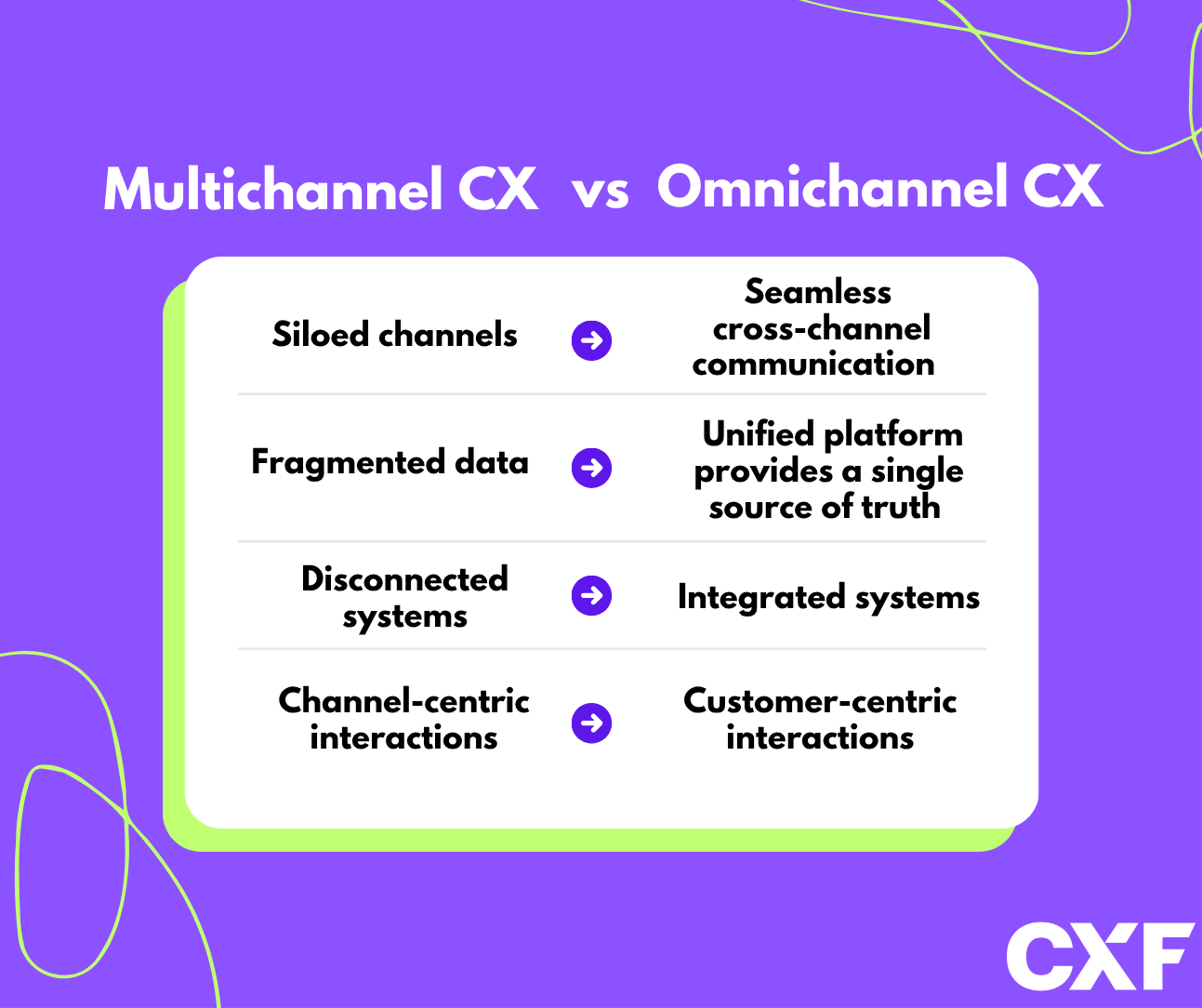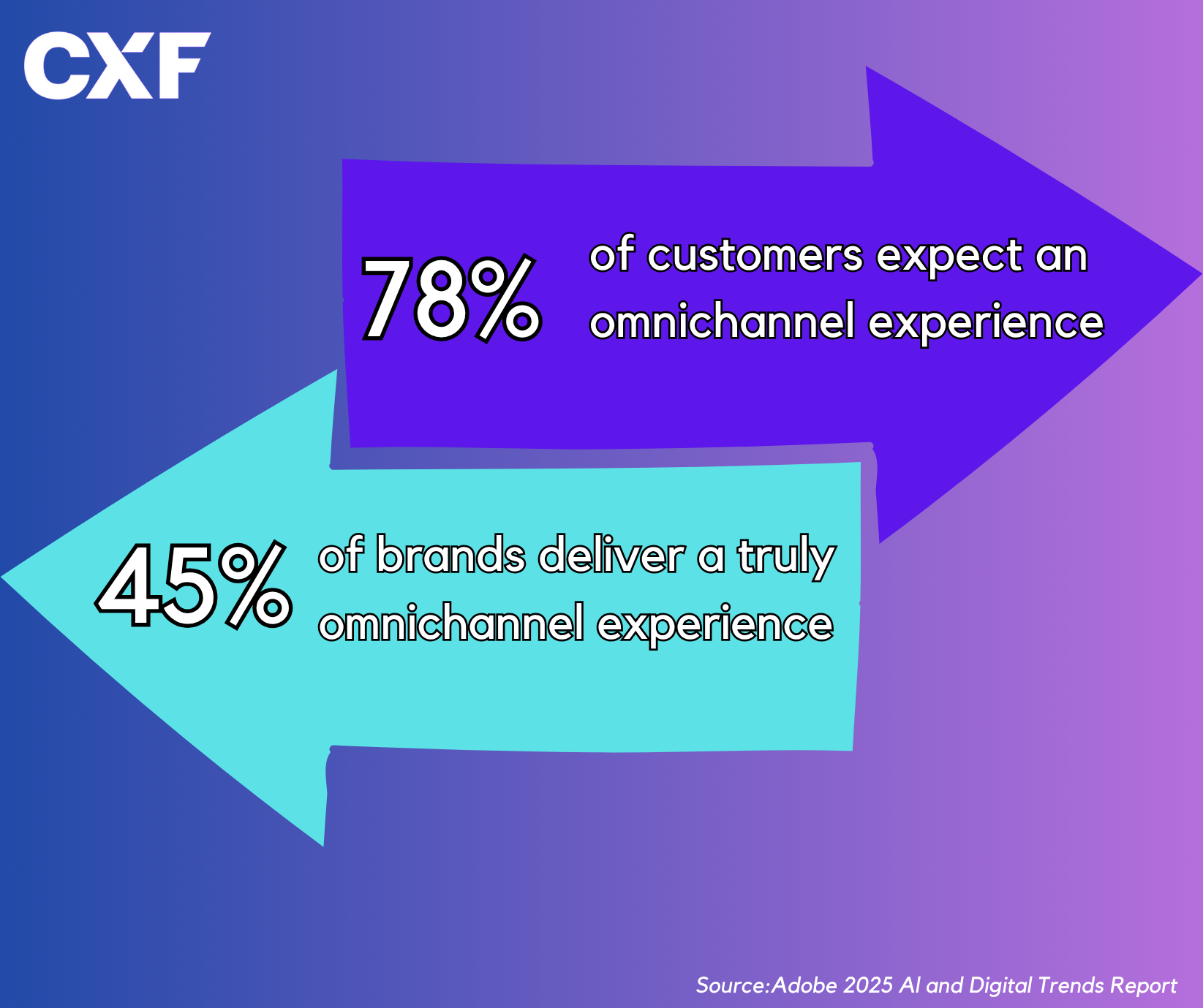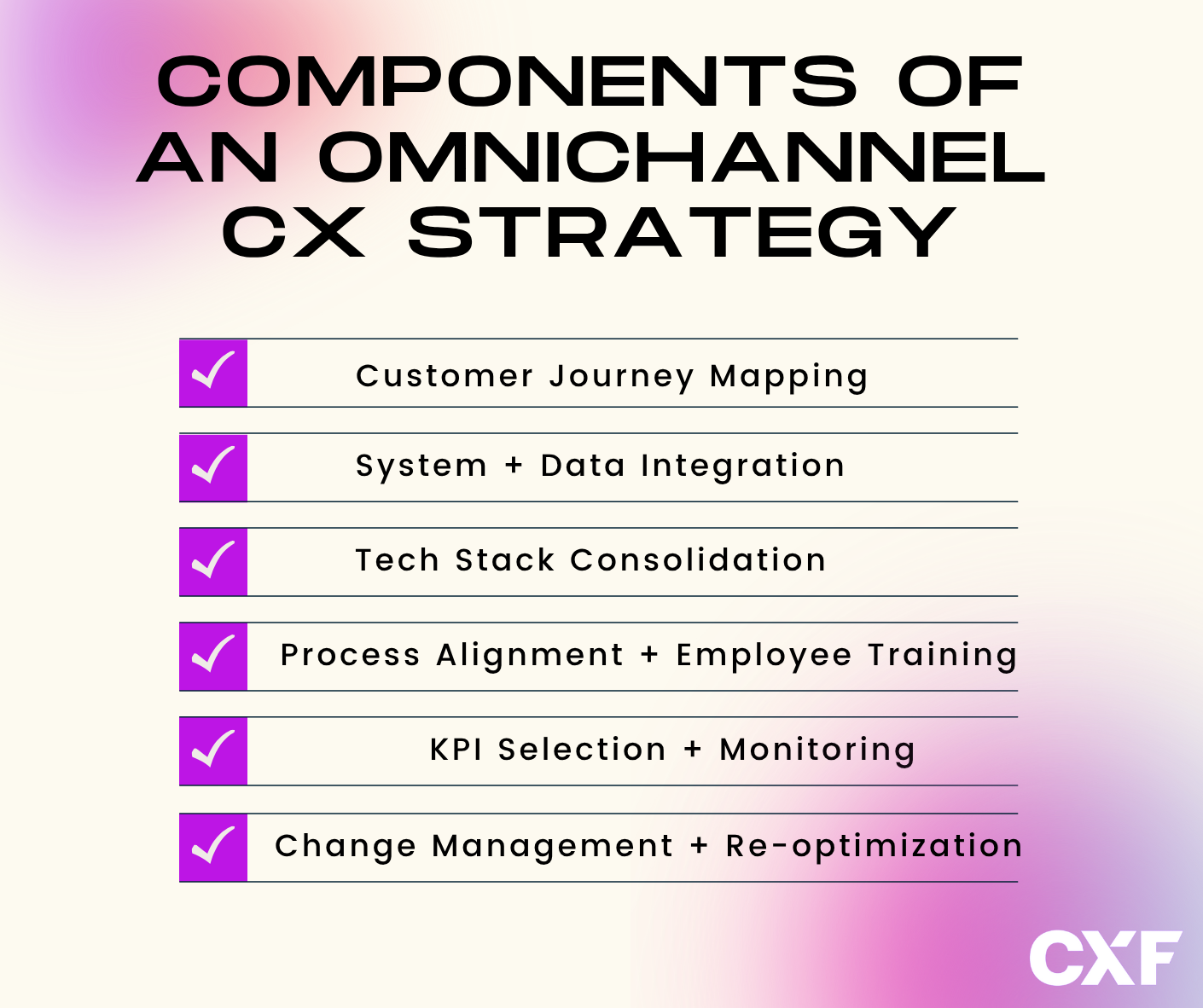July 15, 2025 • 11 min read
Omnichannel Customer Experience: The Enterprise Executive Guide

CX Analyst & Thought Leader
July 15, 2025

10 Best Practices for Enterprise Omnichannel CX Success
Don’t have time to read the whole article? Check out our 10 best practices for enterprise-level omnichannel customer experience:
- Establish a Unified Data Foundation: Select a single, centralized customer data platform that aggregates data from all touchpoints, applications, channels, and systems for 360-degree customer views
- Implement Seamless Cross-Channel Integration and Orchestration: Deploy a single orchestration platform that lets customers switch between channels without repeating themselves
- Leverage AI and Machine Learning for Hyper-Personalization and Automation: Use AI to create personalized customer experiences through intelligent routing, Agent Assist, dynamic scripting, CRM screen pops, automated responses, and proactive engagement
- Adopt a Robust, Cloud-Based Technology Infrastructure: Implement modern, cloud-based CX platforms that enable advanced AI features, scalability, and seamless data integration across all systems
- Foster Enterprise-Wide Organizational Alignment and Collaboration: Break down organizational silos by establishing cross-functional teams with shared goals and metrics
- Optimize the Customer Journey: Use comprehensive customer journey mapping to identify pain points and friction areas while continuously learning from customer behavior
- Prioritize Ethical AI Use, Data Privacy, and Security: Establish robust ethical AI governance frameworks with transparent data handling practices that address consumer privacy concerns and build trust
- Embrace a Culture of Continuous Improvement and Adaptability: Implement a test-and-learn approach that tracks well-defined KPIs, gathers performance feedback, and adapts strategies based on real-world results and evolving customer expectations
- Maintain Human-Centric CX Design: Ensure customers can easily access human agents when needed while using AI to enhance self-service options
- Invest in Employee Upskilling and AI Training: Provide comprehensive technical and soft skill employee training to empower contact center agents to excel in an AI-augmented environment
What is Omnichannel Customer Experience?
An omnichannel customer experience is about giving customers a smooth, consistent, and personalized way to connect with a business across all channels, like phone, apps, websites, or in-store. It uses connected technology to let customers switch between these channels without repeating themselves or starting over, creating a seamless and hassle-free experience.
Providing a frictionless omnichannel customer experience requires uniting all customer-facing and back-end technology systems into a single platform. This eliminates data silos, creates holistic customer profiles, and provides complete context for every interaction.
AI has fundamentally shifted the omnichannel approach from a channel-centric experience to a customer-centric one. Before enterprise AI, the focus was on omnichannel communication alone. “Omnichannel” meant little more than a customer interaction history that included conversations from both voice and digital channels in a single interface.
Now, enterprises can leverage AI to create an omnichannel “experience” that anticipates customer needs, caters to customer preferences, personalizes customer service, and optimizes customer journeys across all touchpoints.
Omnichannel vs Multichannel vs Single-Channel

Omnichannel experiences are the result of decades of CX evolution.
First, there was single-channel customer communication, where customers only talked to businesses through one channel (usually phone calls or in-person conversations.) While this meant all conversation history and customer data was stored in one place, it also limited customers to the channel of the business’s choosing. Customers were forced to adapt to the business's preferred communication method, regardless of their own preferences or the nature of their inquiry.
Multi-channel communication allowed customers to reach out on the voice or digital channel of their choosing. While offering flexibility, multichannel communication siloed conversations and data by channel instead of sharing them. If customers switched channels, they’d have to begin the conversation from scratch–and agents wouldn’t have any insight into prior interactions or customer preferences. The result? Fragmented conversations, extended support resolution times, and endless repetition that infuriated customers.
Omnichannel CX isn’t just about providing multiple channel options, it’s about creating a unified and interconnected experience that caters to customer preferences. In an omnichannel environment, customer data, interaction history, and context flow freely between all channels and touchpoints. A customer can start a purchase on a business’s mobile app, continue the conversation via website chat, and complete the transaction in-store.
Why Omnichannel CX is Non-Negotiable for Enterprise Success
Customer expectations have fundamentally shifted, making omnichannel capabilities a business imperative, not a competitive advantage. 97% of customers expect seamless transitions between channels, and over ¼ of will stop working with companies that make them repeat themselves.[*]
The rise of real-time omnichannel engagement reflects customers' increasingly dynamic communication patterns. 75% of customers have used multiple channels to complete a single interaction in the past year, and 40% of contact centers have experienced an increased demand for 24/7 customer support.[*]
Omnichannel communication doesn’t just meet customer expectations: it drives retention and revenue. Companies with strong omnichannel engagement retain 89% of customers, see a 39% boost in CSAT scores, and increase customer lifetime value by up to 30%.[**] Compared to single-channel users, customers who use at least 4 communication channels are 23% more likely to make repeat purchases. Retailers with omnichannel operations report 27% lower fulfillment costs and 18% reduced cart abandonment, with omnichannel engagement boosting CLV by 30%.[*]
The gap between expectation and delivery remains substantial—78% of consumers expect consistent experiences across digital and physical channels, but only 45% of brands effectively deliver this consistency.[*]

The problem?
Despite all these benefits, less than half of enterprises currently have true omnichannel capabilities in place.[*]
Bridging this gap requires a strategic approach built on an understanding of the foundations of omnichannel CX.
Building the Foundation: Core Elements of an Omnichannel Strategy
Building a successful omnichannel strategy requires more than simply offering multiple communication channels. It demands a fundamental transformation of how businesses collect, analyze, and act on customer data–while orchestrating seamless experiences across all touchpoints. To create a future-proof omnichannel strategy, businesses should focus on:
Robust Technology Infrastructure and Cloud Platforms
A unified customer data platform (CDP) is the foundation of an effective omnichannel CX strategy. CDP software collects and integrates data from multiple systems and channels to create a holistic profile for every customer that’s updated in real-time. Businesses can identify customer behavioral patterns, shopping and channel preferences, and effective marketing strategies.
Other cloud-based solutions like CX platforms and CCaaS software leverage advanced AI-powered features while integrating various systems seamlessly. A point of sale (POS) system that integrates natively with e-commerce platforms centralizes sales channels, operations, and back-end processes, providing a single source of truth for product, order, and customer data.
These platforms enable interoperability and scalability, allowing organizations to rapidly adapt and integrate new technologies as customer expectations and business needs evolve.
The ultimate goal extends beyond traditional omnichannel approaches to truly "channel-less" experiences where the medium becomes invisible to the customer. This requires sophisticated routing and context-sharing capabilities that maintain conversation continuity and customer history across all interactions, creating a unified experience that feels natural and effortless.
AI-Powered Personalization and Automation
AI and machine learning serve as the intelligence layer that tailors experiences, recognizes customer intent, predicts needs, and provides relevant recommendations and proactive offers. These capabilities transform omnichannel from a reactive approach to a predictive one, anticipating customer needs before they're explicitly stated.
AI-powered personalization empowers:
- Relevant product and service recommendations
- Intelligent routing systems to direct customers to the best agent
- Automated responses via chatbots and virtual agents
- In-conversation Agent Assist (next-best-action suggestions)
- Dynamic agent scripting
- Real-time customer sentiment and intent analysis
Customer Journey Mapping and Optimization
Understanding the complete customer journey–customer interactions, sentiment, touchpoints, roadblocks, and intent–is essential for omnichannel optimization. Customer journey mapping identifies opportunities for improvement and proactive intervention, ensuring that technology investments align with actual customer needs and behaviors.
Taking a data-driven approach ensures omnichannel initiatives deliver measurable business value while simultaneously enhancing customer satisfaction.
Organizational Alignment and Collaborative Operating Model
Technology alone cannot deliver omnichannel success. Leadership must champion CX as a core business priority. A strategic, company-wide roadmap with KPIs and clear goals ensures a cohesive approach to customer-centricity.
This organizational transformation often proves more challenging than the technological implementation but remains essential for long-term omnichannel success.
Challenges to Omnichannel CX
While the benefits of omnichannel customer experience are clear, implementing these strategies at enterprise scale presents significant challenges. These obstacles span technical, organizational, and cultural dimensions, requiring comprehensive solutions that address both immediate implementation hurdles and long-term strategic alignment.
Fragmented Data and System Integration Issues
Data fragmentation–caused by a lack of system integration–is the most significant barrier to omnichannel success. 83% of organizations say integration challenges complicate unifying different systems and impede strategic decision-making. Legacy systems only compound these challenges.[*]
Department Silos and Lack of Alignment
Departmental silos are another major barrier to omnichannel CX. While the customer journey– and individual customer interactions–are usually split between different departments, the lack of communication and collaboration across internal teams causes serious issues.
Departments with separate customer engagement solutions, competing departmental priorities, and lack of shared customer data and analytics significantly impact companies' ability to deliver seamless customer journeys.
Evolving Customer Expectations and Experience Gaps
Rapidly evolving customer expectations create a moving target for omnichannel initiatives. A significant disconnect exists between what companies believe they understand about their customers and actual customer sentiment. For example, 81% of brands think they deeply understand customers, but only 46% of customers agree.[*]
Customers expect effortless, personalized, and consistent experiences across all touchpoints. However, they frequently encounter frustrations including long wait times, being forced to use non-preferred channels, inconsistent handoffs between agents and systems, and having to repeat information.
Ethical Concerns Surrounding AI Adoption
While AI is a powerful catalyst for CX transformation, its adoption presents specific ethical and security challenges that organizations must navigate carefully.
Many organizations lack clear roadmaps for AI implementation and clarity around the evolving regulatory landscape. Employee concerns about AI, as well as a lack of organization-wide buy-in, present major obstacles to adoption.
How to Implement a High-Performing Omnichannel Strategy
Here's our step-by-step guide to successful omnichannel strategy implementation for enterprises:

Step 1: Customer Journey Mapping and Analysis
Begin by mapping the complete customer journey across all current touchpoints to identify pain points, drop-off points, and channel transition opportunities. Conduct workshops or use journey mapping tools to visualize how customers interact with your brand. This foundational step reveals the gaps between current state and omnichannel vision, providing a roadmap for strategic improvements.
Step 2: Break Down Data Silos and Integrate Systems
Audit your current technology stack and data repositories across CRM, marketing platforms, POS systems, and e-commerce databases to identify integration opportunities. Plan comprehensive integration through a Customer Data Platform (CDP) to create single customer profiles accessible across all departments. Data integration serves as the foundation for omnichannel success, requiring early involvement from IT and data teams.
Step 3: Choose the Right Technology Stack
Select an integrated technology ecosystem that includes a CRM/Customer Data Platform for unified customer profiles, marketing automation tools for coordinated campaigns across channels, and e-commerce/POS integration for seamless online-to-offline experiences. Incorporate AI and chatbot platforms to scale customer service and recommendations, plus analytics and journey orchestration tools to monitor cross-channel behavior and automate next-best actions. Emphasize cloud-based solutions with strong API capabilities and integration-friendly architectures.
Step 4: Align Teams and Processes
Break down organizational silos by ensuring marketing, sales, customer service, and IT teams align on omnichannel strategy through cross-functional teams and governance structures. Develop consistent brand guidelines for uniform messaging across channels and update processes to enable seamless issue escalation between touchpoints. Comprehensive employee training empowers front-line staff to leverage customer data from all channels effectively.
Step 5: Define KPIs to Measure Omnichannel Success
Monitor omnichannel performance through comprehensive metrics spanning customer satisfaction, engagement, and business outcomes. Track customer satisfaction metrics including Net Promoter Score (NPS) to gauge loyalty improvements, Customer Satisfaction (CSAT) scores across channels to ensure consistency, and Customer Effort Score (CES) to measure cross-channel task ease.
Measure engagement and retention through Customer Lifetime Value (CLV) comparisons between multi-channel and single-channel customers, retention rates before and after omnichannel implementation, and repeat purchase rates for omnichannel shoppers. Channel performance metrics should include cross-channel attribution models that assign value to each touchpoint, channel-specific KPIs within broader journey context, and customer journey analytics tracking common paths and drop-offs.
Business outcome metrics encompass revenue per customer increases, overall sales growth and ROI from omnichannel investments, and operational efficiency improvements such as reduced duplicate contacts and increased self-service usage. Establish continuous benchmarking against industry standards and internal baselines to identify improvement opportunities and optimize the omnichannel experience.
Step 6: Change Management and Organizational Transformation
Recognize that omnichannel implementation requires cultural transformation beyond technology deployment through executive steering committees and C-suite sponsorship. Foster internal champions across departments and establish comprehensive training programs with incentive structures to encourage omnichannel process adoption. Effective change management ensures sustainable transformation and employee engagement throughout the implementation journey.
The Future of Customer Experience is Omnichannel
Organizations that successfully implement comprehensive omnichannel strategies, powered by AI and unified data platforms, will not only meet evolving customer expectations but will also drive measurable improvements in retention, satisfaction, and revenue growth. The question is no longer whether to adopt omnichannel capabilities, but how quickly businesses can transform their operations to deliver the seamless, personalized experiences that define competitive advantage in today's market.